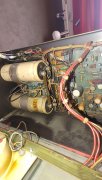Hi All,
I have here my first PL 400. I got it in, checked dc output and was on channel A close to zero on channel B 14 mv. So i gave it a listen.
The amp sounded pretty nice already in this state.
I started to swap the filter caps. One cap was down to 3000 uF. And after the swapped the caps ( to Rubycon 10000 uF) i measured the bias.
Channel A was easy to get right to 0.380 accros the 10 ohm resistor.
Channel B was really low ( 0,0 50) i could not get it any higher than .220 with bias pot turned all the way up.
Any suggestions where to start checking?
Driverboard recap? Or powertransistors?
Thanks for your help!
Menno
I have here my first PL 400. I got it in, checked dc output and was on channel A close to zero on channel B 14 mv. So i gave it a listen.
The amp sounded pretty nice already in this state.
I started to swap the filter caps. One cap was down to 3000 uF. And after the swapped the caps ( to Rubycon 10000 uF) i measured the bias.
Channel A was easy to get right to 0.380 accros the 10 ohm resistor.
Channel B was really low ( 0,0 50) i could not get it any higher than .220 with bias pot turned all the way up.
Any suggestions where to start checking?
Driverboard recap? Or powertransistors?
Thanks for your help!
Menno


